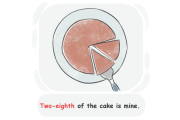What are Numbers?
Numbers are mathematical symbols used to express quantity. We use numbers to count, label, and measure people or objects. We can use numbers everywhere, we use them to tell dates, phone numbers, etc.
Numbers: Types
There are two main groups of numbers in English:
Cardinal Numbers
Cardinal numbers (also called cardinals) are used to count the number of people, animals, or things, such as two, six, twelve, or five hundred. They show how many of those things or people there are.
Placement
Cardinal numbers are commonly used as determiners. In other words, they are typically used before nouns. For example:
I love my pets. I have two dogs, one cat, and five hamsters.
When used as a determiner, they can also take pre-determiners such as articles or possessive determiners before them. For example:
My two dogs are called Jay-Jay and Milly.
We can use cardinal numbers with the following structure:
cardinal numbers + of + determiners
Five of my friends are college graduates.


Tip!
Cardinal numbers can also be used as nouns.
People came to the theater in twos and threes.
Numbers Bigger Than Twenty
If you want to write numbers bigger than twenty, you should use a hyphen between parts of the compound number. In other words, hyphenate all compound numbers between twenty-one and ninety-nine. For example:
thirty-three trees, twenty-seven books
Numbers Bigger Than 100
With numbers bigger than 100, you should use a hyphen between the compound numbers after the word 'and'.
For 100, we can either use the definite article 'a' or use 'one'.
a/one hundred and thirty-three
eight hundred and seventy-nine
In American English, people normally do not use the word 'and':
three hundred fifty-six
Numbers Bigger Than 1,000
When writing numbers larger than 1,000, use a hyphen between compound numbers and include the word 'and'. You can use either the indefinite article 'a' or 'one' for 1,000. Also, remember to use a comma to separate every three digits, such as '80,000'.
a/one thousand (and) one hundred (and) twenty-one
In American English 'and' is mostly not used.
five thousand (and) two hundred (and) thirty-four
Number 0
The number 0 has many names:
in telephone numbers, codes, etc. → oh
in measurements and temperature → zero
in British English → nought
in sports commentary → nil
in tennis → love
What Are Ordinal Numbers?
Ordinal numbers are used to show the order of things on a list or in a row, that's why we call them ordinal. Here are a few examples:
This is the third time you call me, what do you want from me?
She is the eleventh in the queue.
How to Make Ordinal Numbers?
Most of the numbers get th at the end to change to an ordinal number, except the first three numbers. Check out the table below:
first (1st) | twentieth (20th) |
second (2nd) | thirtieth (30th) |
third (3rd) | fortieth (40th) |
fourth (4th) | fiftieth (50th) |
fifth (5th) | sixtieth (60th) |
sixth (6th) | seventieth (70th) |
seventh (7th) | eightieth (80th) |
eighth (8th) | ninetieth (90th) |
ninth (9th) | hundredth (100th) |
tenth (10th) | thousandth (1000th) |
Now let us take a look at the numbers that have more than one part:
twenty-first (21st) | one hundred and thirty-first (131th) |
twenty-second (22nd) | two hundred and forty-fifth (245th) |
twenty-third (23rd) | three hundred and fifty-seventh (357th) |
When Do We Use Ordinal Numbers?
Ordinal numbers are used in many different contexts:
Fractions
A fraction is a particular form of writing numbers. Fractions are used to express a part of a whole or a collection. Here are some examples:
Two-eighth of the cake is mine.
fraction
One-third of this pizza is missing.
Roman Numerals
The letters I, V, X, L, C, D, and M of the Latin alphabet were used to express numbers in ancient Greece. Nowadays. we still use them in some cases. Let's see an example:
Alice III → Alice the third.
Roman number
Telling the Dates and Century
My birthday is on June the sixth.
telling the dates
The castle was built in the thirteenth century.
talking about centuries
How to Write Ordinal Numbers
When writing ordinal numbers in number form, use the last two letters of the ordinal form in a smaller form after the cardinal number. For example:
first = 1st
second = 2nd
third = 3rd
fourth = 4th
Talking about Money & Prices
Each country has its own system of money, such as Dollar in the USA, Pound in the UK, and Euro in European countries. There are different ways to say the prices, Let's go through the common ones:
One, Two, and Three Digit Prices
$4.20 → Four-twenty
just say the numbers
$4.20 → Four dollars (and) twenty
saying 'and' is more common in British English, and Americans usually don't say it.
$4.20 → Four dollars (and) twenty cents
this is the more formal
$580 → five hundred (and) eighty dollars
if the price is an exact number of pounds, euros or dollars we should say it completely.
£100 → a hundred pounds
with prices beginning with 'one' we could use 'a' instead of 'one'.
Four Digit Prices
Mostly, four-digit numbers are read in the same way as we have explained above, but there are some exceptions as well.
$1250 → a thousand two hundred fifty
$5260 → five thousand two hundred sixty
$1500 → fifteen hundred (only in US)
we can also say a thousand five hundred
Comments
(0)
